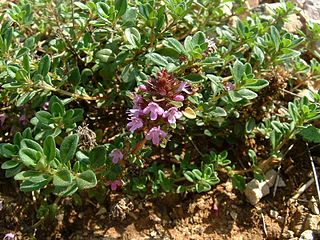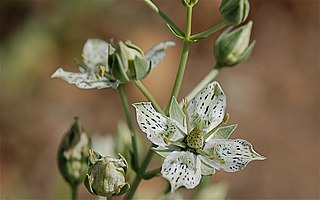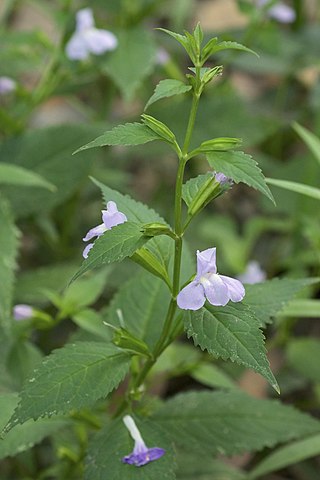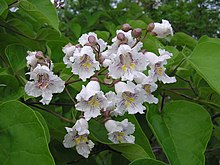
Catalpa, commonly also called catawba, is a genus of flowering plants in the family Bignoniaceae, native to warm temperate and subtropical regions of North America, the Caribbean, and East Asia.

Viburnum lentago, the nannyberry, sheepberry, or sweet viburnum, is a species of Viburnum native to North America.

Oxydendrum arboreum, the sourwood or sorrel tree, is the sole species in the genus Oxydendrum, in the family Ericaceae. It is native to eastern North America, from southern Pennsylvania south to northwest Florida and west to southern Illinois; it is most common in the lower chain of the Appalachian Mountains. The tree is frequently seen as a component of oak-heath forests.

Ceratomia catalpae, the catalpa sphinx, is a hawk moth of the family Sphingidae. The species was first described by Jean Baptiste Boisduval in 1875. Other common names are the Catawba worm, or Catalpa sphinx.

Paulownia is a genus of seven to 17 species of hardwood trees in the family Paulowniaceae, the order Lamiales. The genus and family are native to east Asia and are widespread across China. The genus, originally Pavlovnia but now usually spelled Paulownia, was named in honour of Anna Pavlovna, queen consort of The Netherlands (1795–1865), daughter of Tsar Paul I of Russia. It is also called "princess tree" for the same reason.

Thymus serpyllum, known by the common names of Breckland thyme, Breckland wild thyme, wild thyme, creeping thyme, or elfin thyme, is a species of flowering plant in the mint family Lamiaceae, native to most of Europe and North Africa. It is a low, usually prostrate subshrub growing to 2 cm (1 in) tall with creeping stems up to 10 cm (4 in) long. The oval evergreen leaves are 3–8 mm long. The strongly scented flowers are either lilac, pink-purple, magenta, or a rare white, all 4–6 mm long and produced in clusters. The hardy plant tolerates some pedestrian traffic and produces odors ranging from heavily herbal to lightly lemon, depending on the variety.

Pachypodium brevicaule is a species of plant that belongs to the family Apocynaceae.

Chilopsis is a monotypic genus of flowering plants containing the single species Chilopsis linearis. It is known commonly as desert willow or desert-willow because of its willow-like leaves, but it is not a true willow – being instead a member of the catalpa family.

Catalpa speciosa, commonly known as the northern catalpa, hardy catalpa, western catalpa, cigar tree or catawba, is a species of Catalpa native to the midwestern United States.

Salvia pratensis, the meadow clary or meadow sage, is a species of flowering plant in the family Lamiaceae, native to Europe, western Asia and northern Africa. The Latin specific epithet pratensis means "of meadows", referring to its preferred habitat. It also grows in scrub edges and woodland borders.

Wachendorfia is a genus of perennial herbaceous plants that is assigned to the bloodroot family. The plants have a perennial rootstock with red sap. From the rootstock emerge lance- or line-shaped, sometime sickle-shaped, pleated, simple leaves set in a fan, that are flattened to create a left and right surface rather than an upper and lower surface. The leaves die when the seeds are shed in three of the species, and are perennial in one species. The rootstock also produces flowering stems annually that carry a panicle of zygomorphic, yellow or yellowish flowers in two distinct forms, one with the style and one stamen bent to the right and two stamens to the left, and vice versa. The fruit opens with three valves and each contains a single, hairy seed. All species only occur in the fynbos biome in the Cape Provinces of South Africa.

Ixerba brexioides, the sole species in the genus Ixerba, is a bushy tree with thick, narrow, serrated, dark green leaves and panicles of white flowers with a green heart. The fruit is a green capsule that splits open to reveal the black seeds partly covered with a fleshy scarlet aril against the white inside of the fruit. Ixerba is an endemic of the northern half of the North Island of New Zealand. Common names used in New Zealand are tawari for the tree and whakou when in flower. It is assigned to the family Strasburgeriaceae.
This page provides a glossary of plant morphology. Botanists and other biologists who study plant morphology use a number of different terms to classify and identify plant organs and parts that can be observed using no more than a handheld magnifying lens. This page provides help in understanding the numerous other pages describing plants by their various taxa. The accompanying page—Plant morphology—provides an overview of the science of the external form of plants. There is also an alphabetical list: Glossary of botanical terms. In contrast, this page deals with botanical terms in a systematic manner, with some illustrations, and organized by plant anatomy and function in plant physiology.

Frasera parryi is a species of flowering plant in the gentian family known by the common name Coahuila frasera.

Roscoea cautleyoides is a perennial herbaceous plant occurring in the Sichuan and Yunnan provinces of China. The scientific name is also spelt Roscoea cautleoides. Most members of the ginger family (Zingiberaceae), to which it belongs, are tropical, but R. cautleyoides, like other species of Roscoea, grows in much colder mountainous regions. It is sometimes grown as an ornamental plant in gardens.

Roscoea purpurea is a perennial herbaceous plant occurring in the Himalayas, particularly Nepal. Most members of the ginger family (Zingiberaceae), to which it belongs, are tropical, but species of Roscoea grow in much colder mountainous regions. It is sometimes grown as an ornamental plant in gardens.

Carpodetus serratus is an evergreen tree with small ovate or round, mottled leaves with a toothy margin, and young twigs grow zig-zag, and fragrant white flowers in 5 cm panicles and later black chewy berries. It is an endemic of New Zealand. Its most common name is putaputāwētā which means many wētā emerge - referring to the nocturnal Orthoptera that live in holes in the trunk of this tree made by Pūriri moth caterpillars. Regional variations on the name also refer to this insect that lives and feeds on it such as kaiwētā, and punawētā. The tree is also sometimes called marbleleaf. It is found in broadleaf forest in both North, South and Stewart Islands. It flowers between November and March, and fruits are ripe from January to February.

Mimulus alatus, the sharpwing monkeyflower, is an herbaceous eudicot perennial that has no floral scent. It is native to North America and its blooming season is from June to September. The flowering plant has green foliage and blue to violet flowers. It has a short life span compared to most other plants and a rapid growth rate. Like other monkey-flowers of the genus Mimulus, M. alatus grows best in wet to moist conditions and has a bilabiate corolla, meaning it is two-lipped. The arrangement of the upper and lower lip petals suggests a monkey’s face. The winged stems together with the monkey face give the plant its common name.

Catalpa fargesii, the Chinese bean tree, is a species of tree in the family Bignoniaceae, native to China. Growing to about 25 m tall, it is a deciduous tree which produces abundant pink blossom in spring, followed by narrow brown beans-like fruit in the autumn. Some sources place the species as a synonym of Catalpa bungei.

In botany, floral morphology is the study of the diversity of forms and structures presented by the flower, which, by definition, is a branch of limited growth that bears the modified leaves responsible for reproduction and protection of the gametes, called floral pieces.


























